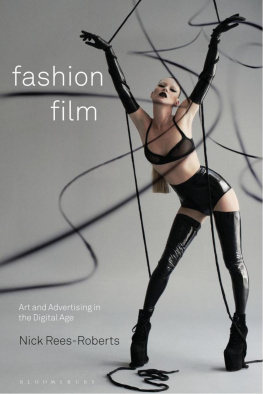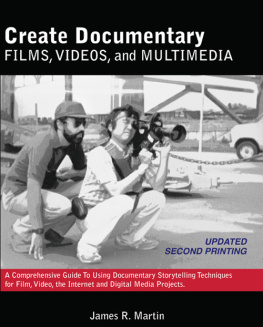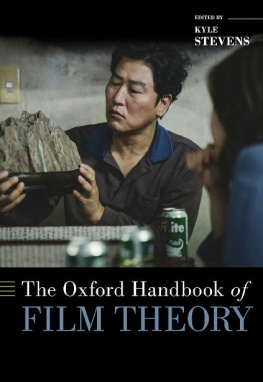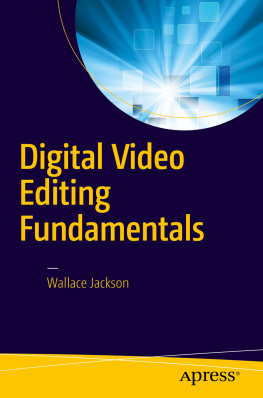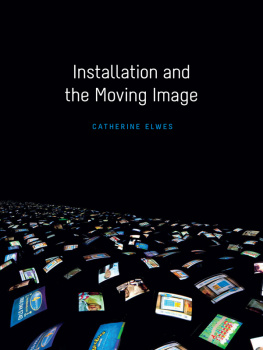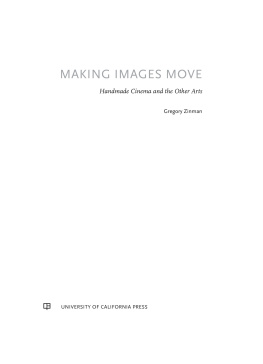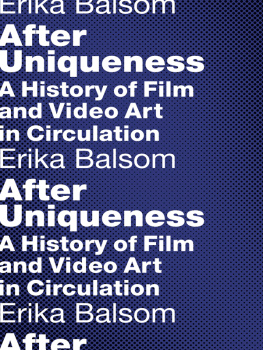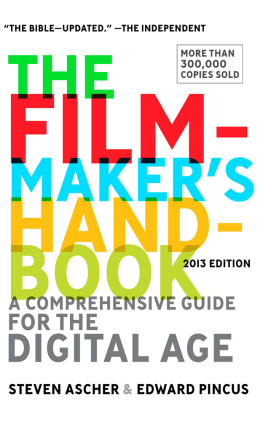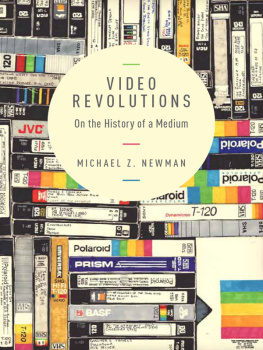Between Film, Video, and the Digital
INTERNATIONAL TEXTS IN CRITICAL MEDIA AESTHETICS
Volume 10
Founding Editor:
Francisco J. Ricardo
Series Editors:
Francisco J. Ricardo and Jrgen Schfer
Editorial Board:
John Cayley, George Fifield, Rita Raley, Tony Richards, Teri Rueb
Volumes in the series:
New Directions in Digital Poetry , C.T. Funkhouser
Cybertext Poetics: The Critical Landscape of New Media Literary Theory , Markku Eskelinen
Creative Enterprise: Contemporary Art between Museum and Marketplace , Martha Buskirk
The Engagement Aesthetic: Experiencing New Media Art through Critique , Francisco J. Ricardo
Software Takes Command , Lev Manovich
3D: History, Theory and Aesthetics of the Transplane Image , Jens Schrter
Projected Art History: Biopics, Celebrity Culture, and the Popularizing of American Art , Doris Berger
When the Machine Made Art: The Troubled History of Computer Art , Grant D. Taylor
The Internet Unconscious: On the Subject of Electronic Literature , Sandy Baldwin
For Sun Joo Lee,
my dearest intellectual colleague
and emotional companion
Between Film, Video, and the Digital
Hybrid Moving Images in the Post-Media Age
JIHOON KIM
Bloomsbury Academic
An imprint of Bloomsbury Publishing Inc

CONTENTS
There was a time, dating back several centuries, when the principal scientific question, in microscopy as much as in astronomical inquiry, was, What is vision? It was important enough to be readable as an epistemological question, principally, What is knowledge? because for the empirical tradition, to know something implied the critical criterion of being able to see it. As such, vision was a philosophical problem; Goethe himself devoted serious study to the question, with particular emphasis on color perception.
But in the last century, vision became mediated; it was no longer the special something that nourished the products of human creation and interpretationpainting, drawing, etchingbut rather was now modulated by instruments of dynamic optical capture and modulationphotography, film and video, television, and computers, for example. Through our physical world we experience direct vision, but no less today, through these instruments we have arrived at mediated vision vision that sees not actual objects, but the representation of objects captured through machinery. After image-making was no longer done by hand, as it had been in the age of painting, interpretation ceased being an active task; for, when images are created by optical systems, interpretation is rendered decidedly passive and contingent on the mechanism that recreates images, and therefore vision itself.
Since the end of the twentieth century, the unrelenting trend toward mediated vision has continued toward a totalizing level of expansion. A worker who sits at a computer for ten hours a day, processing processed images, fails to spend ten hours experiencing objects and images directly. In this new kind of workflow, vision takes place through the virtual tunnel of a digital scope. And so, if historically, when vision was a form of direct experience of the world, it made sense to orient ones inquiry toward the question of What is vision? but it now makes sense to ask the central question of today, with its turn toward visuality of optical modulation: What is a medium? That is to say, since the medium is now what performs the preponderance of image-gathering and construction, that medium, too, comprises, composes, and contributes the active work of vision.
This shift seems to have occurred with little, if any, significant notice. It is as if to claim that, as the notion of medium grew in sophistication and variety, the process of vision, to which it obviously connects, had never changed, or needed to. Instead, philosophers and critics of art and media should have pounced on this development, and announced that vision as a dimension of experience has undergone an ontological transformation. Vision no longer makes the world out of direct engagement; it derives the world in ready-made form out of an array of devices that construct, alter, and interpret that world. Organic visions inner coils of process have been imperceptibly displaced, for the processing of images has already happened before our eyes ever acquire any media-based image.
That is what makes Kims book crucial. It brings back, at a time when mediated vision is still conflated with pre-mediated vision, the ontology of vision through measurable questions, the kinds that philosophers can approach and work withquestions, for example, regarding the identification of an artistic medium, which in turn (thankfully) brings back McLuhans questions about what constitutes a medium and is a question I also have written about many times, as it's central to the critique of all new media art. But while not so long ago, McLuhans time is, nevertheless, not our time. His perspective on vision was still unitary and Romantic; he did not yet live in a world of total immersion to the mediated image, as we do today.
And again, this is why Kims work is required reading for critical thinking about what vision means, beyond what its destination objectthe imagehas become in contemporary times. For example, he understands the importance of probing the concept of hybridization, which someone finally writes about with due rigor. We come to understand in Kims text that a hybrid image is a hybrid form of vision; and so, even the seemingly simple idea of a moving image is unpacked and shown to bein todays new realityrather more complex than was initially apparent. Is a moving image an image that moves, or is it a temporally determined fluctuation of visual changes? The first idea comes from the terrain of photographic thinking, where experimental works like those of Michael Snow or Hollis Frampton are rooted; the second from that of film, whose phenomenal world-in-action was exactly the focus of Dziga Vertov in the early and intense history of cinematic evolution, an aim to capture reality in motion, not in images alone. The Kino-Eye collective wanted to dissolve our bias between image and world, capturing direct realitylife caught unawares, as they liked to say. Thus the question of the image as representative either of a static world or of a kinetic world is not one that can harbor two answers. In any case, Kims analysis of hybridization is the finest I have ever read, and is further subdivided into types like synchronic and diachronic, offering us all of the systematicity in the dimension of media analysis that Ferdinand de Saussure gave us in his still-valid linguistic analysis framework as documented by his students a century earlier.
Nol Carrolls discussions of the moving image here are important to Kims clarifications, along the lines Ive just paved. Carrolls insights, that, for example, Film is not one medium but many media, including ones invented long after 1895, and even some of which have yet to be invented are interpretable not merely through the optic of mediation, as modern history of science likes to trace, but through the mediation of the optical, which is the deeper ground in which the truer sense of this distinction is rooted, and beyond which, by new analysis in Kims exploration, it now necessarily goes. For then, Kim clarifies the sense of hybrid in greater specificity, through operations like nesting of media within mediawhich is, again, what vision does when it is immersed in the collusion of mediated instrumentation. Thus, for Kim, it is necessary to go much further, starting from the brilliant distinction he has uncovered, but which he nonetheless still finds incomplete: that the phenomena of nesting in the digital age has become so complex that it is insufficient merely to acknowledge that a medium contains several media. Rather, what is required is to examine the relations between the media constituting the medium of the moving image. And off we go, past the demise of modernist medium specificity, into an exploratory journey fresh with deep and yet very immediate insight. The idea that vision itself (without even mentioning the word, but rather the alterations of process denoted by that term) has undergone changes in contact with the interrelationship of mediaa term which itself is rigorously unpacked for the filmic dimensionis radically enlightening precisely because Kim starts with, and remains, at the site where the image is rooted.


